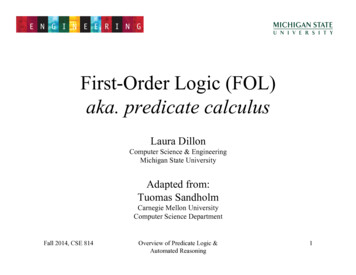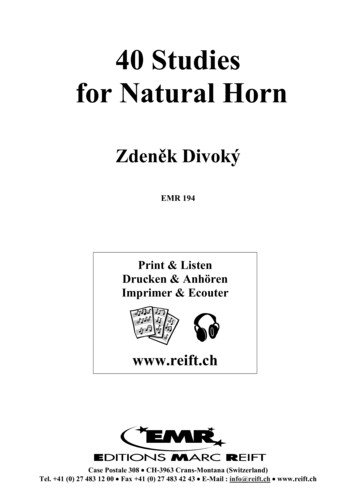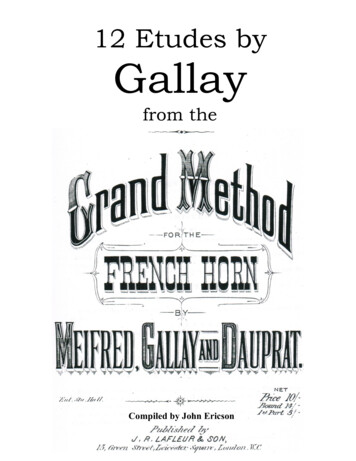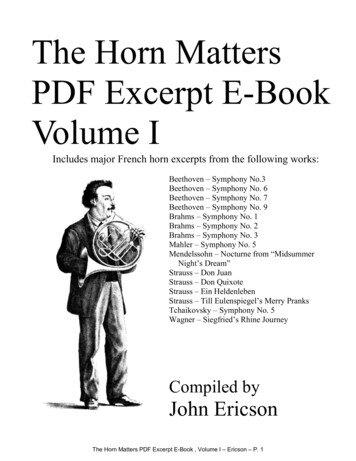
Transcription
KURAM VE UYGULAMADA EĞİTİM BİLİMLERİ EDUCATIONAL SCIENCES: THEORY & PRACTICEReceived: October 29, 2015Revision received: January 9, 2016Accepted: February 26, 2016OnlineFirst: March 30, 2016Copyright 2016 EDAMwww.estp.com.trDOI 10.12738/estp.2016.2.0328 April 2016 16(2) 537-551Research ArticleUsing Horn’s Parallel Analysis Method in ExploratoryFactor Analysis for Determining the Number of Factors1Ömay ÇoklukAnkara University2Duygu KoçakAdıyaman UniversityAbstractIn this study, the number of factors obtained from parallel analysis, a method used for determining the numberof factors in exploratory factor analysis, was compared to that of the factors obtained from eigenvalue andscree plot—two traditional methods for determining the number of factors—in terms of consistency. Parallelanalysis is based on random data generation, which is parallel to the actual data set, using the Monte CarloSimulation Technique to determine the number of factors and the comparison of eigenvalues of those two datasets. In the study, the actual data employed for factor analysis was gathered from a total of 190 primary schoolteachers using the Organizational Trust Scale to explore a teacher’s views about organizational trust in primaryschools within the scope of another study. The Organizational Trust Scale comprises 22 items under the threefactors of “Trust in Leaders,” “Trust in Colleagues,” and “Trust in Shareholders.” A simulative data set with asample size of 190 and 22 items was simulated in addition to the actual data through an SPSS syntax. The twodata sets underwent parallel analysis with the iteration number of 1000. The number of factors was found tobe three. This was consistent with the number of factors obtained in the development process of the scale. Thenumber of factors was restricted to three and exploratory factor analysis was re-performed on the actual data. Itwas concluded that the item-factor distributions obtained as a result of the analyses were consistent with thoseobtained in the scale development study. Hence, parallel analysis was found to provide consistent results withthe construct obtained in the scale development study.KeywordsConstruct validity Parallel analysis Exploratory factor analysis Number of factors The Monte CarloSimulation Technique1 Correspondence to: Ömay Çokluk (PhD), Department of Measurement and Evaluation, Faculty of Educational Sciences,Ankara University, Cebeci, Ankara 06590 Turkey. Email address: cokluk@education.ankara.edu.tr2 Department of Measurement and Evaluation, Adıyaman University, Adıyaman Turkey. Email address: dkocak@adıyaman.edu.trCitation: Çokluk, Ö., & Koçak, D. (2016). Using Horn’s parallel analysis method in exploratory factor analysis for determining the number of factors. Educational Sciences: Theory & Practice, 16, 537-551.
EDUCATIONAL SCIENCES: THEORY & PRACTICEPsychological characteristics are of an abstract or latent nature rather thana tangible, observable one and they are called constructs or factors (Kline, 2005;Nunnaly & Bernstein, 1994). Constructs are hypothetical concepts and the existenceof certain constructs is never absolutely confirmed. Therefore, observations ofindividual behavior mostly provide conclusions about psychological constructs.These psychological constructs such as intelligence, creativity, extrovertedness andintrovertedness are not directly observable (Croker & Algina, 1986). Cronbach andMeehl (1955) define psychological construct as “some postulated attribute of people”(as cited in Baykul, 2000). All constructs have two main features: 1. Every constructis an abstract summary of natural order; 2. Constructs are associated with observableentities or phenomena (Murphy & Davidshofer, 2001).According to Lord and Novick (1968), constructs that are not directly observablecan be defined in two different ways: operational definition, which is essential tomeasure those constructs; and the theoretical relationship between a given constructand others and the relationship between a given construct and criteria in the outerworld in addition to the operational definitions (Crocker & Algina, 1986). Operationaldefinitions of constructs could relate to construct validity studies that discuss thedevelopment of a suitable measuring instrument for a construct and to what extent theinstrument measures the related construct.Construct validity is based on the analysis of the relationships between responsesto test items. To some extent, the process of establishing construct validity for agiven test is the development of a scientific theory (Tekin, 2000). Construct validityis associated with the validity of implications about non-observable variablesthrough observable variables. Construct validity shows how accurately a measuringinstrument measures abstract psychological characteristics. Measuring the relatedabstract construct is based on transformation of the construct into a tangible,observable entity through observable behaviors. The transformation process into anobservable construct includes the following stages: determining behaviors relatedto the measured construct, revealing constructs that are relevant or irrelevant to themeasured construct and showing behavioral patterns that express others related to themeasured construct (Murphy & Davidshofer, 2001).Construct validity studies could be conducted with different methods according tothe quality and the form of a given construct and those of the measuring instrumentused to measure the related construct, whether there are theories and scientificresearch on the construct and some other features (Erkuş, 2003). Factor analysisis the most widely used method among these. In the literature, there is scientificconsensus on the fact that factor analysis is a common statistical method used todetermine construct validity (Anastasi, 1986; Atılgan, Kan, & Doğan, 2006; Crocer538
Çokluk, Koçak / Using Horn’s Parallel Analysis Method in Exploratory Factor Analysis for Determining.& Algina, 1986; Cronbach, 1990; Dancey & Reidy, 2004; Erkuş, 2003; Pedhazur &Pedhazur, Schmelkin, 1991; Urbina, 2004). Because of the advantage entailed byinternal dependencies in constructs by nature, factor analysis reduces the complexityof data and thus provides nearly the same amount of information as extensive dataobtained by a number of original observations, with only a few factors (Çokluk,Şekercioğlu, & Büyüköztürk, 2010).According to Floyd and Widaman (1995), factor analysis has two approachesin the evaluation of psychological constructs: exploration and variable reduction.The exploratory aim of factor analysis defines lower dimensions of measuringinstruments that represent a given construct, on the basis of the theoretical structurefrom which the instruments have been developed. Accordingly, the analysis focuseson the exploration of latent variables that form the basis of a scale. Variable reductionin factor analysis is associated with obtaining the number of indicators, which couldbe considered as a summary, with the maximum variability and reliability in anextensive set of variables.Depending on the aim, factor analysis could be classified as exploratory and confirmatoryfactor analysis. In exploratory factor analysis, there is a process of determining factors,with reference to the relationships between variables and developing a theory; whereasa pre-defined hypothesis of intervariable relationships is tested in confirmatory factoranalysis (Kline, 1994; Stevens, 1996; Tabachnick & Fidell, 2001).The most critical, top priority stage of the analysis is “deciding the number of factors,”although there are certain considerations in exploratory factor analysis performance(variance ratios explained by factors, factor loadings of items, items with high factorloadings more than one factor, and so on) (Fabrigar, Wegener, MacCallum, & Strahan,2009; Hayton, Allen, & Scarpello, 2004; Henson & Roberts, 2006; O’Connor, 2000;Fava & Velicer, 1992; Zwick & Velicer, 1986). Deciding the number of factors is farmore important than other decisions, such as selection of analytical method and thetype of rotation, because the power of exploratory factor analysis depends on the abilityto discriminate significant factors from others. Thus, it is vital to determine the precisebalance between correlations. Also, determining the number of factors needs closeattention because more or fewer factors than necessary will lead to serious errors thataffect results (Comrey & Lee, 1992; Gorsuch, 1983; Harman, 1976).There have been many recommended approaches in determining the number offactors since Spearman developed the factor analysis method. The following two arethe most widely known: determining factors as significant with an eigenvalue greaterthan 1 (also known as the Kaiser-Guttmanrule) and examining the scree plot (Fabrigaret al., 1999; Ford, MacCallum, & Tait, 1986; Wang & Weng, 2002; Weng, 1995).However, methods for determining the number of factors are not restricted to those.539
EDUCATIONAL SCIENCES: THEORY & PRACTICE“Parallel analysis,” suggested by Horn (1965) is another approach to determine thenumber of factors, and a number of studies in the literature show this method to givegood results (Reilly & Eaves, 2000; Sarff, 1997; Velicer, Eaton, & Fava, 2000; Wang,2001; Zwick & Velicer, 1986). It is seen that parallel analysis has become widely usedover the recent years, with the development of user-friendly software, although it isnot included in the most frequently used programs such as SPSS and SAS (Enzmann,1997; Kaufman & Dunlap, 2000; Lautenschlager, 1989; Longman, Cota, Holden, &Fekken, 1989; O’Connor, 2000; Thompson & Daniel, 1996). In the follow up processof Horn’s research (1965), studies conducted by Humphreys and Ilgen (1969) andHumphreys and Montanelli (1975) have shown that the parallel analysis method iseffective in determining the number of factors. Various methods such as regressionmethods, interpolation tables and the mean eigenvalues have also been developed tomake parallel analysis performance easier (Allen & Hubbard, 1986; Keeling, 2000;Lautenschlager, 1989; Lautenschlager, Lance, & Flaherty, 1989; Longman et al.,1989; Montanelli & Humphreys, 1976).Parallel analysis is based on random data simulation to determine the numberof factors. Using the Monte Carlo Simulation Technique, a random simulative(artificial) data set is generated besides the actual (real) data set and the estimatedeigenvalues are calculated. When the method is employed, the number of factorswhere the eigenvalue in the simulative sample is higher than that of the actual data isconsidered significant (Ledesma & Mora, 2007).Parallel analysis (Horn, 1965) is a sample matrix based adaptation of the K1method, in which factors with eigenvalues greater than 1 are considered significant,on the basis of the correlation matrix of the population. In the K1 method, the sumof squared values of (factor loadings) correlation coefficients between a factor anda number of variables is called eigenvalue and factors with eigenvalues greater than1 are considered significant. Cliff (1988) states that the method is affected by thesampling error and it tends to result in a great (excessive) number of factors whenapplied to the sample matrix. The method is extensively used because it is userfriendly and it is merely applied to the correlation matrix of the population. Themethod tends to determine an excessive number of factors as sampling error is addedas a rank to the correlation matrix in restricted samples (Gorsuch, 1983). Horn (1965)suggests that Eigen values of a given correlation matrix of a population-scale p numberof variables could be 1 but the initial eigenvalues in simulative samples are equal to1, and the following eigenvalues could be lower than 1 because sampling error isadded to the matrix. Therefore, components or factors with greater eigenvalues, whencompared to the simulative matrix besides the actual data are considered significant(Zwick & Velicer, 1986). If an m data set with a magnitude of N is randomly extractedfrom a population of a normal distribution and m variables are correlated, an mxm540
Çokluk, Koçak / Using Horn’s Parallel Analysis Method in Exploratory Factor Analysis for Determining.correlation matrix is expected to be close to a unit matrix. Sampling theory points outthat such a proximity between a correlation matrix and a unit matrix is a function ofm and N. Also, the theory stipulates that the average correlation equals 0 and varianceof correlation is inversely correlated with sample size. Eigen values of a correlationmatrix could be considered as the variance of the variables independently extractedfrom m variable (Horn, 1965).Horn (1965) states that the effects of sampling error on eigenvalues of correlationmatrices must be of concern while determining the number of factors in the eigenvaluegreater than 1 method, as it leads to determining an excessive number of factors whensamples are used that are restricted in number (smaller samples). Thus, it is advisablethat correlation matrices obtained from randomly chosen data should be comparedto those in the actual data. The mean eigenvalues of correlation matrices obtainedfrom randomly chosen data sets include and reflect the effects of a given samplingerror (Wengand & Cheng, 2005).As parallel analysis sometimes tends to give anexcessive number of factors, it is emphasized that the Type I error could decrease (α)by keeping eigenvalues obtained from simulative data at a confidence interval of.05,and thus, results would be more accurate this way (Buja & Eyüboğlu, 1992; Glorferd,1995; Harshman & Reddon, 1983). Some researchers suggest that parallel analysisshould be incorporated with a scree plot (Fabrigar et al., 1999; Ford et al., 1986).Horn (1965) asserts that iteration in data must be at a reasonable value although thereis no strict rule about the number of iterated data sets used to calculate the meaneigenvalues. To some researchers, this number is 500–1000 (Hayton et al., 2004),but there are studies that have shown no significant difference between 1 and 100(Crawford & Koopman, 1979).Silverstein (1977; 1987) compared the K1 method and the parallel analysismethod in 24 data sets, and parallel analysis was found to give better results. Zwickand Velicer (1986) compared five methods employed in factor determining (parallelanalysis, the minimum average partial correlation method, the scree plot, Bartlett’sChi-Square Test, eigenvalue greater than 1) under different conditions such as samplesize, the number of variables and components, factorial saturation, the number ofvariables per component and single and complex variables etc., and concluded thatparallel analysis was consistent with the actual data set used to determine the numberof factors, with 92% accuracy.Humphreys and Montanelli (1975) compared the parallel analysis method to themaximum likelihood method, and parallel analysis was found to give results thatwere consistent (almost 100%) with the number of factors obtained from the actualdata set. Dinno (2009; 2010) examined the consistency of the parallel analysismethod with the number of factors obtained from the actual data set for both factor541
EDUCATIONAL SCIENCES: THEORY & PRACTICEanalysis and principal components analysis, by changing distribution properties ofthe simulative data in the parallel analysis method and concluded that the methodswere independent of the distribution (distribution-free) properties of data, and that fordetermining number of factors, parallel analysis was found to give results that wereconsistent with the number of factors obtained from the actual data set.Crawford et al. (2010) compared the parallel analysis method, the principalcomponents and principal factor methods and the criteria for the mean Eigen value tothose of an eigenvalue of 95%. As a result of the analyses, it was concluded that theaccuracy percentage of the criterion for the eigenvalue of 95% depended on the itemnumber per factor and gave the most accurate results in finding the initial eigenvalue.For the resulting eigenvalues, principal components analysis was found to give betterresults than principal factor analysis in the case of a single factor or a low correlationbetween factors. Factor analysis, based on the mean eigenvalue criterion, was foundto give better results in multi-factor models in which the correlation between factorswas high and the factor constructs were robust.As is clear from the above-mentioned discussions, studies have shown that parallelanalysis is an effective method for determining the number of factors. Despite beingthe most critical, top priority issue of factor analysis, determining the number offactors has been considered as one of the most challenging stages; this is particularlytrue for researchers inexperienced in factor analysis, although it is occasionallydifficult for many experienced researchers, depending on the characteristics of theinstrument (or scale), the research group and thus the collected data. This emphasizesthe need for further empirical evidence to support the accuracy of the decisions aboutthe number of factors. To this end, the research problem is parallel analysis of thenumber of factors obtained from the actual and the simulative data set and examiningthe consistency of the resulting numbers of factors.MethodThe study aims to compare the numbers of factors obtained from the parallel analysismethod, a method in exploratory factor analysis for determining the number of factorsto those from the eigenvalue and the scree plot graphic methods, which are traditionalmethods for determining the number of factors and examine their consistency. In thissection, the measuring instrument and the simulative data set are mentioned.InstrumentThe “Organizational Trust Scale,” developed by Yılmaz (2005), was used in thestudy to determine the number of factors. The Organizational Trust Scale consists of22 items under three factors: “Trust in Leaders,” “Trust in Colleagues,” and “Trust542
Çokluk, Koçak / Using Horn’s Parallel Analysis Method in Exploratory Factor Analysis for Determining.in Shareholders.” The first factor consists of seven items and the Cronbach-alphareliability coefficient is α .89. The second factor consists of eight items and theCronbach-alpha reliability coefficient is α .87. The third factor consists of sevenitems and the Cronbach-alpha reliability coefficient is α .82. The total varianceexplained by the whole scale is 45.31% and the Cronbach-alpha reliability coefficientis α .92 (Yılmaz, 2006).Data SimulationThe research used the data collected from a total of 190 primary school teachersin the scope of a study by Çokluk and Yılmaz (2008) to explore primary schoolteachers’ views about organizational trust, using the Organizational Trust Scale. Adata set was simulated through a syntax written in SPSS besides the actual data, witha sample size of 190 and the item number of 22. The process was arranged with theiteration number of 1000 and the two data sets underwent parallel analysis.FindingsIn this section, the results of the parallel analysis of the actual data set and thesimulative (artificial) data set are mentioned.Parallel analysis, suggested by Horn (1965) as a method to determine the numberof factors, is based on the comparison of eigenvalues of the actual data to those of thesimulative data. In parallel analysis, eigenvalues of the determined factors in randomlysimulated data set are compared to those of the factors in the actual data set. In thisprocess, the focal point is how many of the factors obtained from the actual data havean eigenvalue greater than that of the simulative data and accordingly the numberof factors is decided. The number of factors at the point where the eigenvalue in thesimulative data is greater than that of the actual data is considered significant (Uyar,2012). All studies (Gorsuch, 1983; Horn, 1965; Linn 1968; Revelle, 2007; Zwick &Linn, 1986) that compared a number of factor determination methods specified thatthe parallel analysis method performs accurate estimations in determining numberof factors, and also eigenvalue and scree plot methods tend to ascertain on overdetermining the number of factors.In the study, exploratory factor analysis was applied to the Organizational TrustScale in order to show how parallel analysis was employed to determine the numberof factors. To this end, the results of Kaiser-Meyer-Olkin (KMO) values and Bartlett’sTest of Sphericity were examined to test the eligibility of the Organizational TrustScale in factor extraction. KMO 0.899 and Bartlett’s Test of Sphericity were foundsignificant [c2 2576.085, p .01]. The findings showed that factor analysis couldbe performed on the Organizational Trust Scale. The actual data and the simulative543
EDUCATIONAL SCIENCES: THEORY & PRACTICEdata underwent parallel analysis through a syntax written in SPSS. Results of theexploratory factor analysis is presented in Table 1.Table 1Percentages of Eigen Value, Explained Variance and Cumulative Variance as a Result of the Factor AnalysisFactorEigenvalue (%)Explained variance (%) Cumulative variance 57.05341.1484.99162.04450.9864.28766.331When Table 1 is examined, the eigenvalues’ methods according to four factorsseem to set out a structure. Exploratory factor analysis of the obtained scree plot ispresented in Graphic 1.Graphic 1. The scree plot of the factor analysis.The scree plot graphic shows that there is a four-factor solution, and the number offactors correspond to the number of factors determined via the eigenvalue methods. Itis emphasized that generally these two methods conform to each other; however, theyperform an over-determining number of factors (Ford et al., 1986; Hayton et al., 2004).544
Çokluk, Koçak / Using Horn’s Parallel Analysis Method in Exploratory Factor Analysis for Determining.Table 2Eigen Values of the Actual Data and the Simulative DataFactorEigen values of the actual data18.89022.54031.67741.06450.980Eigen values of the simulative data1.7831.6291.5311.4411.364As mentioned above, the intended use of parallel analysis provides further evidenceor a basis to decide the number of factors more easily. When Table 1 is examined, it isseen that the eigenvalue of the first factor in the actual data is 8.890, while it is 1.783in the simulative data set. The eigenvalue of the second factor in the actual data is2.540, whereas it is 1.629 in the simulative data. The eigenvalue of the third factor inthe actual data is 1.677, while it is 1.531 in the simulative data. When we shift fromthe third factor to the fourth, the case is different and thus the number of the scalefactors is determinedly restricted to 3 because the eigenvalue of the simulative dataof the fourth factor is higher than that of the actual data. The eigenvalue of the fourthfactor in the actual data is 1.064, whereas it is 1.44 in the simulative data. This caseshould be considered as the point at which parallel analysis introduces a decisionabout the number of factors.It is likely to observe the number of factors decided with the support of parallelanalysis in the same way as seen on the scree plot presented in Graphic 2.Graphic 2. The scree plot of the actual data and the simulative data.545
EDUCATIONAL SCIENCES: THEORY & PRACTICEWhen the scree plot in Graphic 2, which presents the curves of the actual data alongwith the simulative data, is examined, it is obvious that the three-factor constructdecided as a result of the examination of the eigenvalues is supported. In the graphic,it is seen that the first three factors of the actual data have higher eigenvalues than thefirst three factors of the simulative data and as of the third factor, the eigenvalues ofthe simulative data are greater.The number of factors performed via the eigenvalue and scree plot methods do notcorrespond to the number of factors obtained from the scale development study, andthe number of factors were found to be more than expected. In addition, the numberof factors found via the parallel analysis method correspond to the number of factorobtained from the scale development study.As a result of the above-mentioned observations, the number of the scale factorsin the study was decided to be three and the analysis was re-performed on the actualdata*, with that restricted number.Table 3Percentages of Eigen value, Explained Variance and Cumulative Variance as a Result of the Factor Analysison the Actual DataFactorEigenvalue (%)Explained variance (%)Cumulative variance 59.583*It is not likely to run exploratory factor analysis on simulative data. That is why the presented results ofexploratory factor analysis are of the actual data.When Table 3 is examined, it is clearly seen that the total explained variance asa result of the re-performed exploratory factor analysis with a restricted numberof factors to three is 59.583%. Results of the exploratory factor analysis of theOrganizational Trust Scale are presented in Table 4.Table 4Factor Analysis Results of the Organizational Trust ScaleFactor 1Factor 2ItemRotated factor loadingItemRotated factor 546Item167228261321Factor 3Rotated factor loading0.7240.7230.7200.7110.6870.5780.5320.480
Çokluk, Koçak / Using Horn’s Parallel Analysis Method in Exploratory Factor Analysis for Determining.When Table 4is examined, as a result of the varimax rotation, the first factorconsists of items 1, 15, 5, 12, 9, 10 and 17; the second factor consists of items 20, 4,3, 18, 11, 19 and 14; and the third factor consists of items 16, 7, 22, 8, 2, 6, 13 and21. It is also clear that the rotated factor loadings in the first factor range from 0.600to 0.866; those in the second factor range from 0.617 to 0.753 and the rotated factorloadings of the items in the third factor range from 0.480 to 0.724.It has been concluded that the results of the exploratory factor analysis are consistentwith those obtained in the scale development study by Yılmaz (2006). In other words,the results of the study overlap with the item-factor distribution defined in the originalscale development study. When the validity and reliability study of the OrganizationalTrust Scale is examined, it is seen that the scale consists of three factors and theyare respectively named “Trust in Leaders,” “Trust in Shareholders” and “Trust inColleagues.” All these findings could be interpreted as indicators of consistent resultsof the parallel analysis method with the actual data in deciding the number of factors.DiscussionThis study attempted to give examples of the use of the parallel analysis method,one of the methods in factor analysis which is used to determine the number of factors.As determining the number of factors constitutes one of the most critical issuesin exploratory factor analysis and there are occasional difficulties in the decisionprocess, further empirical evidence to support such decisions could be needed.Hence, employing the parallel analysis method is considered to assist researchers andother practitioners in exploratory factor analysis applications.Examinations within the scope of the research have shown that the parallel analysismethod is found to have consistent results with the actual data set in determining thenumber of factors and the original scale. In other words, the parallel analysis methodhas been found to give good results in determining the accurate number of factors.The result is consistent with the other study findings in the literature. For example, ina study by Zwick and Velicer (1986), which compared the methods for determiningthe number of factors, it was concluded that the parallel analysis in any conditions wasfound to give the best results in the examinations of determinin
factor analysis. In exploratory factor analysis, there is a process of determining factors, with reference to the relationships between variables and developing a theory; whereas a pre-defined hypothesis of intervariable relationships is tested in confirmatory factor analysis (Kline, 1994; Stevens, 1996; Tabachnick & Fidell, 2001).











